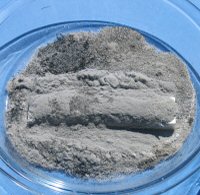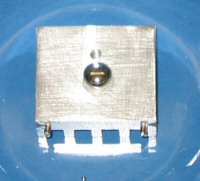Mercury and Aluminium
A lot of websites state that a violent reaction will take place when liquid mercury comes into contact with aluminium. I noticed a lack of photographic evidence backing this statement up, so I decided to run the experiment myself. This webpage documents my results.
Mercury
 |
|
The mercury I'm using on this page is tripple distilled. I don't have any scales so I can't give precise measurements in the amounts I use, but the pictures should hopefully give a good idea.
Aluminium
 |
|
Aluminium is an extremely popular light weight metal which reacts with oxygen to form an aluminium oxide layer.
4Al(s) + 3O2(I) -> 2Al203(s)
The aluminium oxide layer protects the underlying aluminium from coming into contact with any more oxygen. This gives aluminium a very high resistance to oxidiation, which is one of the reasons for its popularity.
Pure aluminium is fairly soft and so it is often alloyed with different metals to increase its strength. One of the most popular aluminium alloys is duralumin (94% Al, 4% Cu, 1% Mg), which is light weight like aluminium but somewhat stronger. Other types of aluminium alloys can be constructed with different properties, which is what makes aluminium so useful.
Aluminium and its alloys are often anodized to further increase there resistance to oxidiation. This is necessary as the protective aluminium oxide layer is fairly thin and easily damaged. Anodizing the aluminium effectively thickens the aluminium oxide layer. The anodizing process uses a solution of sulfuric acid (H2SO4) and electrolysis, with the aluminium taking the place of the anode.
The Experiments
I've now performed quite a few experiments with mercury and aluminium and I can safely say that the reaction is not violent. Infact, even getting the reaction to start in the first place is fairly difficult. If the mercury is simply placed on the aluminium, and it doesn't roll off, it will just rest on top of the aluminium oxide layer. The mercury in the following picture was left on the aluminium, which had a small ditch drilled in it, for 1 hour without anysort of visible reaction taking place.Maybe the aluminium had been anodized to give it an extra thick aluminium oxide layer, but the mercury in the above image is actually sat in a ditch I drilled, which was probably 4mm deep. Surely the a 4mm ditch would penetrate any anodized oxide layer. I tried further to break the protective layer down by sanding and scratching it in the presence of the mercury, but even this seemed to have little to no effect. So something else was needed to get the reaction started.
After some more research it was determined that one of the options was to melt a tiny amount of gallium onto the aluminium. The mercury could then be applied to the gallium, which would then allow the original reaction between the mercury and the aluminium to take place. At this moment in time this is what I've been experimenting with and the results are noticably different.
You will probably notice that no accurate timing information is provided in the experiments. I can't really think of a good excuse for this other than I didn't record it very accuratly. The pictures I choosen in the sequences are choosen because they represent the results the best. At some points the reaction seems to stop, or slow right down, so I add water, which speeds everything backup. The times for this really depend on when I'm watching what's happening.
 | Experiment 1 - Al Heat Sink |
 | Experiment 2 - Al Bar |
 | Experiment 3 - Al Bar |
Future Experiments with Hg and Al
Aluminium Powder and MercuryConclusion
| Home |
